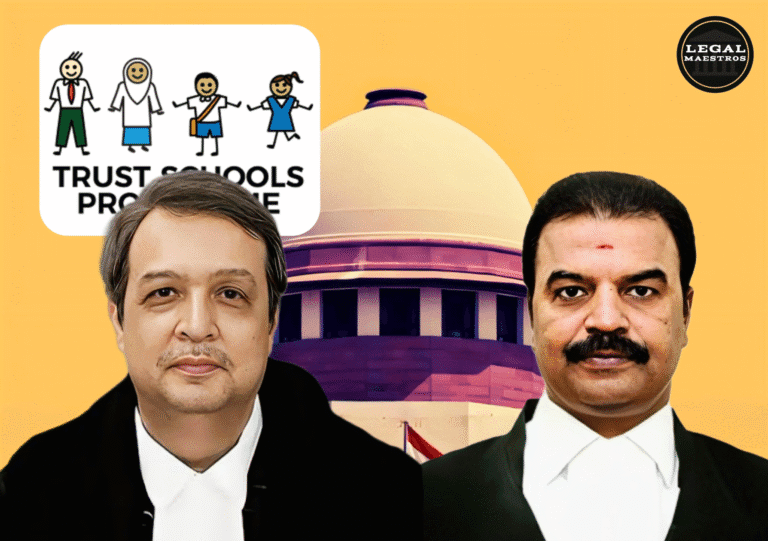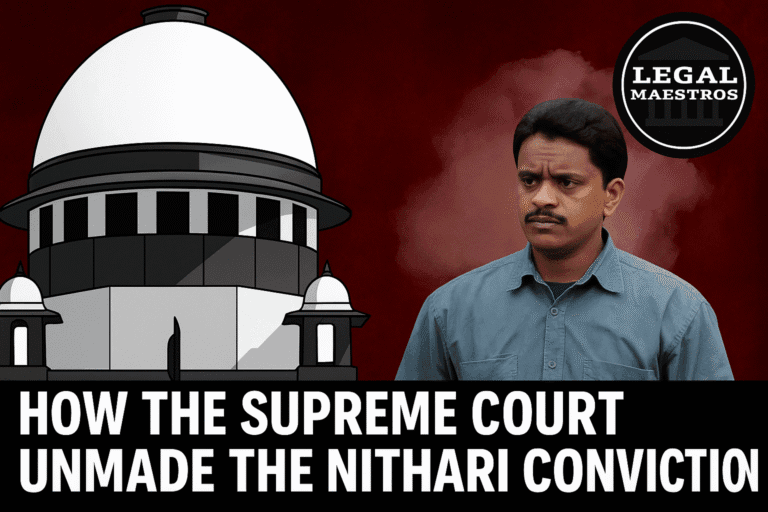
In the Angadi Chandranna v. On April 22, 2025, the Supreme Court of India passed a landmark judgment in Shankar & Ors. that dealt with some vital aspects of law of Hindu property and appellate court jurisdiction.In the case of Angadi Chandranna v. Shankar & Ors., the Supreme Court of India issued a key ruling on April 22, 2025, which addressed crucial areas of Hindu property law and appellate court jurisdiction.
The judgment was given within the context of the situation. The decision that was handed down by Justice R. Mahadevan not only sheds light on the distinction between self-acquired property and ancestral property in the context of Hindu joint family law, but it also establishes firm judicial boundaries on the re-appreciation of facts in second appeals with regard to Section 100 of the Civil Procedure Code (CPC).
An Overview of the Facts
The disagreement centered on a piece of property in Karnataka that was first granted to C. Thippeswamy via a family division in the year 1986. The land measured seven acres and twenty guntas. Subsequently the appellant, Angadi Chandranna, purchased the property of defendant No. 1 C. Jayaramappa in the year 1993.
For any queries or to publish an article or post or advertisement on our platform, do call at +91 6377460764 or email us at contact@legalmaestros.com.
In the year 1989 Jayaramappa had already bought the land along with his brother Thippeswamy. In the lawsuit, the plaintiffs, who are Jayaramappa’s sons and daughters, said that the land in question was ancestral property and demanded that it be partitioned and that they be given separate control of it.
In spite of the fact that the trial court had found in their favor, the first appeal court overturned the ruling and determined that the land in question was property that Defendant No. 1 had bought on their own. On the other hand, the ruling of the lower court was upheld by the High Court, which therefore prompted the appellant to seek the Supreme Court.
Consideration Given to Legal Provisions
- There were two primary legal concerns that the Supreme Court focused on:
- If the property in question was inherited or purchased by the plaintiff themselves.
- According to Section 100 of the Criminal Procedure Code, whether or not the High Court had the jurisdiction to re-examine factual findings.
The necessity of sticking to the limits of second appeals under Section 100 was emphasized by Justice Mahadevan. Section 100 only permits involvement where there is a genuine issue of law, and not only differences over facts. In its criticism of the High Court, the Court said that the High Court had exceeded its authority by re-evaluating evidence and making factual findings without first posing any such significant legal issue.
For any queries or to publish an article or post or advertisement on our platform, do call at +91 6377460764 or email us at contact@legalmaestros.com.
Identification of the Characteristics of the Property
One of the most important questions that needed to be answered was whether or not the land in question had kept the form of ancestral property even after the split.
The plaintiffs asserted that the defendant No. 1 had used the nucleus or joint family finances to acquire the land, and that as a result, the children had a birthright claim to the property. On the other hand, the defendant argued that he purchased the property using his own funds in addition to a loan from a third party (DW3).
A concept that the Court stated is that once a property is partitioned, each share becomes the self-acquired property of the individual receiver, unless it can be shown that the recipient did not acquire the share. The simple fact that a joint family exists does not always mean that the property will continue to be held jointly.
For any queries or to publish an article or post or advertisement on our platform, do call at +91 6377460764 or email us at contact@legalmaestros.com.
Either the property must have been obtained with cash from the joint family nucleus or it must have been inherited from paternal ancestors in order for it to be considered ancestral. Additionally, in accordance with the idea of blending, any property that was earned by the individual’s own means may only be considered joint if it is freely put into the common pool.
Evaluation of the Evidence and the Obligation to Prove It
It was highlighted by Justice Mahadevan that the party alleging the ancestral nature of property is the one who is responsible for providing evidence to support their claim. In their attempt to establish that the property was purchased using monies from the joint family or revenue from assets that had been previously divided, the plaintiffs were unsuccessful.
It was established beyond a reasonable doubt by the defendants’ oral testimony and the documentation that they presented that Defendant No. 1 had obtained a loan in order to fund the transaction.
For any queries or to publish an article or post or advertisement on our platform, do call at +91 6377460764 or email us at contact@legalmaestros.com.
Additionally, the court did not accept the plaintiffs’ assertion that the cash used to purchase the property originated from a grandmother since it could not discover any documented proof or testimony to back up this assertion. Inconsistencies in the plaintiffs’ assertions, in addition to the absence of any financial proof, further undermined the plaintiffs’ claim.
The implementation of the doctrine of the need of the law
In addition, the Supreme Court agreed with the defendant’s contention that the transaction was carried out in order to fulfill family commitments, such as the marriage of his daughter. In accordance with Hindu law, a Karta, who is the head of the family, has the authority to sell family property in order to satisfy a legal need or for the benefit of the estate. It was accepted by the court that the funds received from the sale were, in fact, used for the utilization of such essentials.
A mistake made by the High Court
A significant portion of the decision was devoted to addressing the incorrect procedure that was carried out by the High Court. The Supreme Court made the observation that the High Court had erroneously relied on the theory of blending and had incorrectly identified the dispute property, which was not the property that had been acquired via a will but rather one that had been purchased at a later time.
For any queries or to publish an article or post or advertisement on our platform, do call at +91 6377460764 or email us at contact@legalmaestros.com.
In addition, the High Court re-appreciated factual material that had previously been examined by the first appeal court without raising any serious legal questions, which is completely contrary to the provisions of Section 100 of the Criminal Procedure Code.
The Court further brought to the attention of the parties that, according to Section 103 of the CPC, factual re-determination is only allowed in situations where the lower courts have not yet reached a decision on a matter and there is evidence already present in the record. In the present scenario, none of these prerequisites were satisfied.
The ruling of the first appeal court was upheld by the Supreme Court, which said that the land in question was the property that Defendant No. 1 itself had obtained via his own means. The sale that was made in favor of the appellant was deemed to be legitimate, and the claims that were made by the plaintiffs were rejected.
For any queries or to publish an article or post or advertisement on our platform, do call at +91 6377460764 or email us at contact@legalmaestros.com.
This ruling restates ideas that have been established for a long time in Hindu law and procedural legal law. Specifically, it outlines the circumstances under which a piece of property might be considered self-acquired as opposed to ancestral, and it underscores that higher courts are not permitted to exceed their authority by re-evaluating evidence in second appeals. As a guidepost for similar conflicts concerning family property and the boundaries of judicial review under CPC, the verdict serves as a guidepost.






![Research Assistantship @ Sahibnoor Singh Sindhu, [Remote; Stipend of Rs. 7.5k; Dec 2025 & Jan 2026]: Apply by Nov 14, 2025!](https://legalmaestros.com/wp-content/uploads/2025/11/Gemini_Generated_Image_s0k4u6s0k4u6s0k4-768x707.png)
![Karanjawala & Co Hiring Freshers for Legal Counsel [Immediate Joining; Full Time Position in Delhi]: Apply Now!](https://legalmaestros.com/wp-content/uploads/2025/11/Gemini_Generated_Image_52f8mg52f8mg52f8-768x711.png)